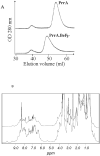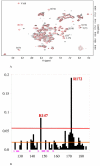Activation of the global gene regulator PrrA (RegA) from Rhodobacter sphaeroides
- PMID: 16784239
- PMCID: PMC2517121
- DOI: 10.1021/bi060683g
Activation of the global gene regulator PrrA (RegA) from Rhodobacter sphaeroides
Abstract
PrrA is a global transcription regulator activated upon phosphorylation by its cognate kinase PrrB in response to low oxygen levels in Rhodobacter sphaeroides. Here we show by gel filtration, analytical ultracentrifugation, and NMR diffusion measurements that treatment of PrrA with a phosphate analogue, BeF(3)(-), results in dimerization of the protein, producing a protein that binds DNA. No dimeric species was observed in the absence of BeF(3)(-). Upon addition of BeF(3)(-), the inhibitory activity of the N-terminal domain on the C-terminal DNA-binding domain is relieved, after which PrrA becomes capable of binding DNA as a dimer. The interaction surface of the DNA-binding domain with the regulatory domain of PrrA is identified by NMR as being a well-conserved region centered on helix alpha6, which is on the face opposite from the DNA recognition helix. This suggests that there is no direct blockage of DNA binding in the inactive state but rather that PrrA dimerization promotes a correct arrangement of two adjacent DNA-binding domains that recognizes specific DNA binding sequences.
Figures






Similar articles
-
Interacting specificity of a histidine kinase and its cognate response regulator: the PrrBA system of Rhodobacter sphaeroides.Microbiology (Reading). 2006 Aug;152(Pt 8):2479-2490. doi: 10.1099/mic.0.28961-0. Microbiology (Reading). 2006. PMID: 16849810
-
Solution structure and DNA binding of the effector domain from the global regulator PrrA (RegA) from Rhodobacter sphaeroides: insights into DNA binding specificity.Nucleic Acids Res. 2003 Dec 1;31(23):6778-87. doi: 10.1093/nar/gkg891. Nucleic Acids Res. 2003. PMID: 14627811 Free PMC article.
-
Transcriptional activation of the Rhodobacter sphaeroides cytochrome c(2) gene P2 promoter by the response regulator PrrA.J Bacteriol. 2002 Jan;184(2):390-9. doi: 10.1128/JB.184.2.390-399.2002. J Bacteriol. 2002. PMID: 11751815 Free PMC article.
-
RegB/RegA, a highly conserved redox-responding global two-component regulatory system.Microbiol Mol Biol Rev. 2004 Jun;68(2):263-79. doi: 10.1128/MMBR.68.2.263-279.2004. Microbiol Mol Biol Rev. 2004. PMID: 15187184 Free PMC article. Review.
-
RegB/RegA, a global redox-responding two-component system.Adv Exp Med Biol. 2008;631:131-48. doi: 10.1007/978-0-387-78885-2_9. Adv Exp Med Biol. 2008. PMID: 18792686 Review.
Cited by
-
Regulation of gene expression by PrrA in Rhodobacter sphaeroides 2.4.1: role of polyamines and DNA topology.J Bacteriol. 2009 Jul;191(13):4341-52. doi: 10.1128/JB.00243-09. Epub 2009 May 1. J Bacteriol. 2009. PMID: 19411327 Free PMC article.
-
Regulation of the Rhodobacter sphaeroides 2.4.1 hemA gene by PrrA and FnrL.J Bacteriol. 2008 Oct;190(20):6769-78. doi: 10.1128/JB.00828-08. Epub 2008 Aug 8. J Bacteriol. 2008. PMID: 18689483 Free PMC article.
-
Intracellular adaptation of Brucella abortus.J Proteome Res. 2009 Mar;8(3):1594-609. doi: 10.1021/pr800978p. J Proteome Res. 2009. PMID: 19216536 Free PMC article.
-
Role of the global transcriptional regulator PrrA in Rhodobacter sphaeroides 2.4.1: combined transcriptome and proteome analysis.J Bacteriol. 2008 Jul;190(14):4831-48. doi: 10.1128/JB.00301-08. Epub 2008 May 16. J Bacteriol. 2008. PMID: 18487335 Free PMC article.
-
Development of the bacterial photosynthetic apparatus.Curr Opin Microbiol. 2006 Dec;9(6):625-31. doi: 10.1016/j.mib.2006.10.005. Epub 2006 Oct 20. Curr Opin Microbiol. 2006. PMID: 17055774 Free PMC article. Review.
References
-
- Swem LR, Elsen S, Bird TH, Swem DL, Koch HG, Myllykallio H, Daldal F, Bauer CE. The RegB/RegA two-component regulatory system controls synthesis of photosynthesis and respiratory electron transfer components in Rhodobacter capsulatus. J. Mol. Biol. 2001;309:121–138. - PubMed
Publication types
MeSH terms
Substances
Grants and funding
LinkOut - more resources
Full Text Sources
Molecular Biology Databases

